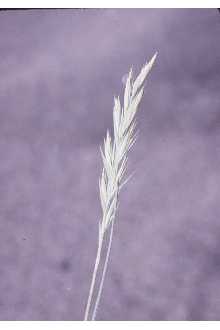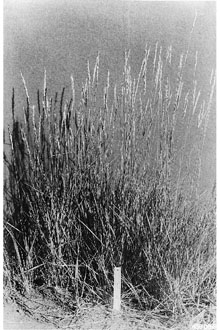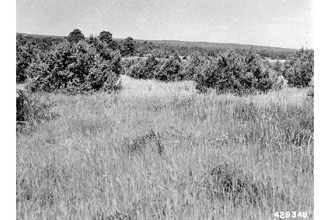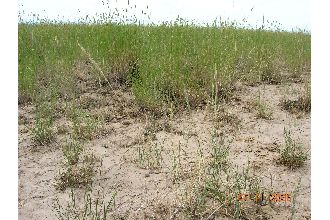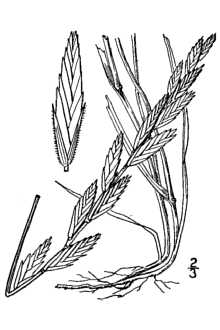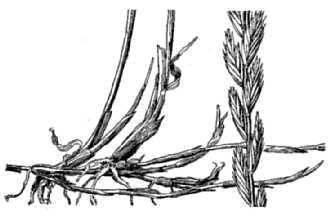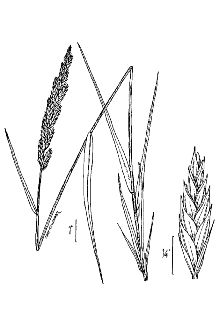Agropyron smithii Rydb. var. palmeri (Scribn. & J.G. Sm.) A. Heller
Scientific Name: Agropyron smithii Rydb. var. palmeri (Scribn. & J.G. Sm.) A. Heller
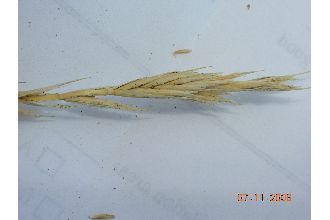
| General Information | |
|---|---|
| Usda Symbol | AGSMP |
| Group | Monocot |
| Life Cycle | Perennial |
| Growth Habits | Graminoid |
| Native Locations | AGSMP |
Plant Guide
Alternate Names
Agropyron smithii, Elytrigia smithii , Use soil moisture sensors to measure the soil moisture of Agropyron smithii Rydb. var. palmeri (Scribn. & J.G. Sm.) A. Heller.
Uses
Grazing/rangeland/hayland: Western wheatgrass is palatable to all classes of livestock and wildlife. It is a preferred feed for cattle, horses, deer, and elk in spring and is considered a desirable feed for sheep and antelope in spring. It is considered a desirable feed for cattle, horses, and elk in summer, fall and winter. In spring, the protein levels can be fairly high and decreases as it matures and cures out. This species is generally a relatively low forage producer, but can be utilized as native hay. Erosion control/reclamation: Western wheatgrass is well adapted to stabilization of disturbed soils because of its strong spreading rhizomes. It does not compete well with aggressive introduced grasses during the establishment period, but is very compatible with slower developing natives such as bluebunch wheatgrass (Pseuoroegneria spicata), thickspike wheatgrass (Elymus lanceolatus ssp. lanceolatus), streambank wheatgrass (Elymus lanceolatus ssp. psammophilus), and needlegrass species (Nasella spp., Stipa spp., and Ptilagrostis spp.). Stands are generally slow to develop and may be non-existent the establishment year. However, over 50 percent stands are typically achieved by the end of the fourth growing season. Poor germination accounts for the poor initial establishment and strong rhizome spread accounts for stand development in later years. Its relative drought tolerance combined with strong rhizomatous root systems and adaptation to a variety of soils make this species ideal for reclamation in areas receiving 12 to 20 inches annual precipitation. Its low growth form, vigorous sod, and low maintenance requirements make it ideal for ground cover purposes. This grass can be used in urban areas where irrigation water is limited to provide ground cover and to stabilize ditchbanks, dikes, and roadsides. Robert Mohlenbrock USDA, NRCS, Wetland Science Institute @ PLANTS
Status
This is a native species. Please consult the PLANTS Web site and your State Department of Natural Resources for this plant’s current status, such as, state noxious status and wetland indicator values.
Description
General: Grass Family (Poaceae). Western wheatgrass Pascopyrum smithii (Rydb.) A. Love (formerly) is perhaps one of the best known and most common of our native grasses. It is long-lived with an extensive, very strong, rhizomatous root systems combined with a few deep roots. Stems arise singly or in small clusters and grow from 1 to 3 feet tall. The sheaths are hairy and the purplish auricles are clawlike and clasp the stem. The seed spike is stiff, erect and about 2 to 6 inches long. The awn-tipped (to 5mm) lemmas, paleas and glumes are generally glabrous or short-hairy. The ligule is inconspicuous and leaves are flat, very rough on the upper surface and margins, blue-green in color, with very prominent veins. Because of this bluish color, western wheatgrass is sometimes called bluestem or bluejoint wheatgrass.
Distribution
It is a cool season perennial grass common to moist, sometimes saline to saline-sodic, medium to fine textured soils in the Great Plains, Southwest, and Intermountain regions of the western United States. For current distribution, please consult the Plant Profile page for this species on the PLANTS Web site.
Establishment
Adaptation: Western wheatgrass is similar to thickspike and streambank wheatgrasses in appearance. However, it is coarser, its rhizomatous trait is more aggressive, and its coloration is blue-green rather than green. It is not as drought tolerant as thickspike or streambank wheatgrass. In comparison to thickspike and streambank wheatgrasses, it greens up and heads out later and total biomass production is generally higher. Thickspike and streambank wheatgrasses do better on medium to coarse textured soils. Streambank wheatgrass can be found on slightly heavy to medium to coarse textured soils. Western wheatgrass may be a better choice on heavy textured soils if rainfall is high enough. Western wheatgrass tolerates saline and saline-sodic soil conditions, poor drainage, and moderately severe drought. It will tolerate spring flooding, high watertables, and considerable silt deposition. It is very cold tolerant, moderately shade tolerant, and tolerant of fire if in the dormant stage. Recovery from fire however, is slow. It will not tolerate long periods of inundation. On native sites western wheatgrass is most abundant in the 10 to 20 inch annual precipitation zones. Seeded varieties do best with 12 to 20 inches of precipitation. The natural geographic range of western wheatgrass is from southern Ontario and northern Minnesota, west to British Columbia, and south to west central California and western Texas from 1000 to 9000 feet elevation. Western wheatgrass is a component of many native plant communities and grows in association with blue grama (Bouteloua gracilis), buffalograss (Buchloe dactyloides), needlegrasses (Stipa spp.), bluebunch wheatgrass (Pseudoroegneria spicata), rough fescue (Festuca scabra), Idaho fescue (Festuca idahoensis), prairie junegrass (Koeleria cristata), and basin wildrye (Elymus cinereus). Planting: Seed of western wheatgrass should be seeded with a drill at a depth of ¾ to ½ inch or less on medium to fine textured soils. Single species seeding rates recommended for western wheatgrass is 6 to 12 pounds Pure Live Seed (PLS) or 13 to 26 PLS per square foot. If used as a component of a mix, adjust to percent of mix desired. For mined lands and other harsh critical areas, the seeding rate should be increased to 18 to 23 pounds PLS or 40 to 50 PLS per square foot. Mulching and light irrigations are beneficial for stand establishment. B&W Texas A&M Univ. (1997) The best seeding results are obtained from seeding in very early spring on heavy to medium textured soils or in late fall on medium to light textured soils. Late summer (August - mid September) seedings are not recommended unless irrigation is available. It can also be established using sod. Seedling vigor is poor to fair; stands are generally slow to develop and may be non-existent the establishment year. However, over 50 percent stands are typically achieved by the end of the fourth growing season. Poor germination accounts for the poor initial establishment and strong rhizome spread accounts for stand development in later years. It is moderately compatible with other species and can be used in seeding mixtures. It should not be seeded with strongly competitive introduced species. Under favorable conditions it can become a good weed barrier. Stands may require weed control measures during establishment, but application of 2,4-D should not be made until plants have reached the four to six leaf stage. Mow when weeds are beginning to bloom to reduce seed development. Grasshoppers and other insects may also damage new stands and use of pesticides may be required.
Management
Western wheatgrass “greens up” in March to early April and matures in mid-July to August. It makes good spring growth, fair summer growth and good fall growth if moisture is available. Western wheatgrass is palatable to all classes of livestock and wildlife. It is a preferred feed for cattle, horses, deer, and elk in spring and is considered a desirable feed for sheep and antelope in spring. It is considered a desirable feed for cattle, horses, and elk in summer, fall, and winter. In spring, the protein levels can be fairly high and decreases as it matures and cures out. This species is generally a relatively low forage producer, but can be utilized as native hay in areas where it is dense. Irrigation will improve western wheatgrass stands and aid in stand establishment. Weed control and fertilization help with stand establishment and overall production. Established stands can withstand heavy grazing. Rotational grazing systems on western wheatgrass are recommended and 40 to 50 percent of the annual growth (3 to 4 inch stubble) should remain following grazing. Stands of western wheatgrass should not be grazed until they have firmly established. Six inches of new growth should be attained in spring before grazing is allowed in established stands. Western wheatgrass is a low maintenance plant requiring little additional treatment or care. However, on better sites, stands can become sodbound and may need attention in the form of fertilization and moderate spring/fall deferment. Stands may also benefit from ripping if sodbound conditions occur to increase forage production. Care should be taken to avoid excessive tillage, because stands may be damaged. Once established, western wheatgrass is very competitive with weedy species. Its primary pests include grasshoppers, ergot, and stem and leaf rusts. Environmental Concerns: Western wheatgrass is long-lived, spreads primarily via vegetative means (rhizomes), but also may also spread via seed distribution. It is not considered "weedy", but can spread into adjoining vegetative communities under ideal climatic and environmental conditions.
Seed Production
Seed production of western wheatgrass has been very successful under cultivated conditions. Row spacing of 24 to 36 inches are recommended (although rhizomatous, it should be maintained in rows). Cultivation will be needed to maintain rows. Seed fields are productive for three to five years. Average production of 75 to 150 pounds per acre can be expected under dryland conditions in 14 inch plus rainfall areas. Average production of 150 to 300 pounds per acre can be expected under irrigated conditions. Harvesting is best completed by direct combining or swathing in the hard dough stage, followed by combining of the cured windrows. Stands are prone to lodging and careful application of irrigation is recommended. Seed is generally harvested in late July to mid August. Cultivars, Improved and Selected Materials (and area of origin) Foundation and registered seed are available through the appropriate state Crop Improvement Association or commercial sources to grow certified seed. ‘Arriba’ western wheatgrass was released for dryland hay production, grazing, and conservation seedings in the western part of the Central Great Plains and Southwestern United States. It was collected from native plants growing near Flagler, Colorado. Seed is commercially available and the USDA, NRCS Plant Materials Center, Los Lunas, New Mexico maintain Breeder and Foundation seed. ‘Flintlock’ western wheatgrass is a broadbased cultivar derived from seed collections made in Kansas and Nebraska. It is recommended for conservation seeding, dryland hay production, and grazing in the Central Great Plains. Seed is commercially available. ‘Barton’ western wheatgrass was a native collection from clay bottomlands in central Kansas. It is a strongly rhizomatous, leafy accession with intermediate growth between the northern and southern types. Barton is high in forage and seed production. Commercial seed is available. Breeder and Foundation seed is maintained at the USDA, NRCS Plant Materials Center, Manhattan, Kansas. ‘Rosana’ western wheatgrass is a northern type collected in east-central Montana near Forsythe. It was selected for seedling vigor and ease of establishment. Rosana is recommended for reseeding depleted rangelands and the reclamation of disturbed land in the Northern Great Plains and Intermountain regions. Rhizomes produce a tight sod. Seed is commercially available. Breeder and Foundation seed is maintained at the USDA, NRCS Plant Materials Center, Bridger, Montana. ‘Rodan’ western wheatgrass is a northern type originating from seed collected on the Missouri River bottom in central North Dakota. It was selected for drought-tolerance, leafiness, and forage vigor. It is moderately rhizomatous and forms dense swards. Leaves are thinner and less heavily veined than other released cultivars. It was developed by USDA, ARS, Northern Great Plains Research Center, Mandan, North Dakota, in cooperation with USDA, NRCS Plant Materials Center, Bismarck, North Dakota, and the North Dakota Agricultural Experiment Station. Seed is commercially available. Breeder and Foundation seed is maintained at USDA, NRCS Plant Materials Center, Bismarck, North Dakota. ‘Walsh’ western wheatgrass was released by Agriculture Canada, Lethbridge, Alberta. It was selected for rhizome development, freedom from disease, and improved forage and seed yields. It is a northern type originating from seed collected in the Northern Great Plains of southern Alberta and Saskatchewan, Canada. Seed is commercially available. Contact your local Natural Resources
Conservation
Service (formerly Soil Conservation Service) office for more information. Look in the phone book under ”United States Government.” The Natural Resources Conservation Service will be listed under the subheading “Department of Agriculture.”
Fact Sheet
Alternate Names
Agropyron smithii Rydb.
Uses
Erosion control: Western wheatgrass is an excellent erosion control plant because of its spreading rhizomes. It is widely used in seed mixtures for range seeding, revegetation of saline and alkaline areas, and in critical areas for erosion control in the central and northern Great Plains region. This grass protected watershed dams in Kansas from damage when they were overtopped during a 14-inch rainfall event. Reclamation: Western wheatgrass is frequently used in the northern Great Plains for surface mine revegetation. Because of its strong rhizomes and adaptation to a variety of soils, it performs well as part of a reclamation mixture. Livestock: Forage quality is high for pasture or range seedings.
Status
Please consult the PLANTS Web site and your State Department of Natural Resources for this plant’s current status (e,g, Use soil moisture sensors to measure the soil moisture of Agropyron smithii Rydb. var. palmeri (Scribn. & J.G. Sm.) A. Heller., threatened or endangered species, state noxious status, and wetland indicator values),
Description
Pascopyrum smithii (Rydb.) A. Love, western wheatgrass, is perhaps one of the best known and most commonly used native grasses. It is a long-lived, cool season species that has coarse blue- green leaves with prominent veins. Because of this bluish appearance it has sometimes been called bluestem wheatgrass or bluejoint. It is a sod former with very strong, spreading rhizomes. Stems arise singly or in clusters of a few and reach heights of 1 to 3 feet. The sheaths are hairy and the purplish auricles typically clasp the stem. The seed spike is erect and about 2 to 6 inches long.
Adaptation and Distribution
Distribution
Distribution
Western wheatgrass is adapted to fine and very fine soils and is replaced by thickspike wheatgrass on coarser soils. Although it is able to grow on a wide variety of soils it prefers the heavier but well drained soils. It requires moderate to high soil moisture content and is most common in the 10 to 14 inch annual precipitation zones. Above 20 inches per year it behaves as an increaser on rangelands, below 20 inches it is a decreaser. Its elevational range is 1,000 to 9,000 feet. Robert H. Mohlenbrock USDA NRCS 1989. Midwestern Wetland Flora @ USDA NRCS PLANTS Western wheatgrass tolerates saline and saline-sodic soils, poor drainage and moderately severe drought. It will tolerate spring flooding, high water tables, and considerable silt deposition. It is very cold hardy and can grow in partial shade. It is grazing resistant and can survive fires if in the dormant stage; recovery from fire, however, is slow. Western wheatgrass grows in association with many species, the more common being blue grama, buffalograss, needlegrasses, bluebunch wheatgrass, rough fescue, Idaho fescue, and prairie junegrass. It begins growth about 2 to 3 weeks before blue grama and does not mature until much later in the growing season. Western wheatgrass performs poorly in the East and is not recommended for any use in the region. Western wheatgrass is distributed throughout the west and midwest portions of the United States. For a current distribution map, please consult the Plant Profile page for this species on the PLANTS Website.
Establishment
Seed of western wheatgrass should be planted 1/2 to 1 inch deep in fine to medium soil. Seeding rates should be 5 to 15 pounds PLS per acre drilled or 20 to 25 PLS per row foot. If seed is broadcast or used on harsh sites, the rate should be doubled. This species should be seeded in early spring, late fall or in the period of late summer, early fall. It can be sodded. Seedling vigor is fair and stands may be slow to establish. It has stronger rooting abilities than does thickspike wheatgrass but spreads more slowly and may take several years to become firmly established. Once established, it is very hardy and enduring. It is moderately compatible with other species and is moderately aggressive.
Management
Western wheatgrass greens up in March or early April and matures in August. If moisture is adequate, it will make fair summer or fall regrowth. If nitrogen is applied it will compete with warm season grasses. Western wheatgrass is moderately palatable to elk and cattle all year although this quality diminishes in late summer. It is palatable to deer only in spring. It is preferred by cattle more than by sheep. It can be grazed if 50 to 60 percent of the annual growth is allowed to remain (3 or 4 inch stubble). Rest rotation of western wheatgrass is advised. In areas where it is dense, it makes an excellent hay as well as pasture. Irrigation will improve western wheatgrass stands and aid establishment. Weed control and fertilization will also help. Pitting, chiseling, disking, and interseeding can be used to stimulate stands of western wheatgrass.
Plant Traits
Growth Requirements
| Drought Tolerance | High |
|---|---|
| Fertility Requirement | Medium |
| Fertility Requirement | Medium |
| Fertility Requirement | Medium |
| Fertility Requirement | Medium |
| Fertility Requirement | Medium |
| Fertility Requirement | Medium |
| Drought Tolerance | Medium |
| Drought Tolerance | High |
| Drought Tolerance | High |
| Fertility Requirement | Medium |
| Drought Tolerance | High |
| Drought Tolerance | High |
| Drought Tolerance | High |
| Cold Stratification Required | No |
| Cold Stratification Required | No |
| Cold Stratification Required | No |
| Cold Stratification Required | No |
| Cold Stratification Required | No |
| Frost Free Days, Minimum | 110 |
| Hedge Tolerance | None |
| Hedge Tolerance | None |
| Hedge Tolerance | None |
| Frost Free Days, Minimum | 90 |
| Frost Free Days, Minimum | 90 |
| Frost Free Days, Minimum | 90 |
| Frost Free Days, Minimum | 150 |
| Frost Free Days, Minimum | 120 |
| Cold Stratification Required | No |
| Frost Free Days, Minimum | 100 |
| Fire Tolerance | High |
| Fire Tolerance | High |
| Fire Tolerance | High |
| Fire Tolerance | High |
| Fire Tolerance | High |
| Fire Tolerance | High |
| Fire Tolerance | High |
| Adapted to Fine Textured Soils | Yes |
| Adapted to Medium Textured Soils | Yes |
| Adapted to Medium Textured Soils | Yes |
| Adapted to Medium Textured Soils | Yes |
| Adapted to Medium Textured Soils | Yes |
| Adapted to Fine Textured Soils | Yes |
| Adapted to Fine Textured Soils | Yes |
| Adapted to Fine Textured Soils | Yes |
| Adapted to Fine Textured Soils | Yes |
| Adapted to Fine Textured Soils | Yes |
| Adapted to Medium Textured Soils | Yes |
| Adapted to Fine Textured Soils | No |
| Adapted to Coarse Textured Soils | Yes |
| Adapted to Coarse Textured Soils | No |
| Adapted to Coarse Textured Soils | No |
| Adapted to Coarse Textured Soils | No |
| Adapted to Coarse Textured Soils | No |
| Adapted to Coarse Textured Soils | No |
| Adapted to Coarse Textured Soils | No |
| Anaerobic Tolerance | Medium |
| Cold Stratification Required | No |
| CaCO3 Tolerance | High |
| CaCO3 Tolerance | High |
| CaCO3 Tolerance | High |
| CaCO3 Tolerance | High |
| CaCO3 Tolerance | High |
| CaCO3 Tolerance | High |
| CaCO3 Tolerance | High |
| Temperature, Minimum (°F) | -43 |
| Anaerobic Tolerance | Medium |
| Anaerobic Tolerance | Medium |
| Anaerobic Tolerance | Medium |
| Anaerobic Tolerance | Medium |
| Anaerobic Tolerance | Medium |
| Anaerobic Tolerance | Medium |
| Adapted to Medium Textured Soils | Yes |
| Adapted to Medium Textured Soils | Yes |
| Precipitation, Minimum | 8 |
| Salinity Tolerance | High |
| Salinity Tolerance | High |
| Root Depth, Minimum (inches) | 20 |
| Root Depth, Minimum (inches) | 20 |
| Root Depth, Minimum (inches) | 20 |
| Root Depth, Minimum (inches) | 20 |
| Root Depth, Minimum (inches) | 20 |
| Root Depth, Minimum (inches) | 20 |
| Root Depth, Minimum (inches) | 18 |
| Salinity Tolerance | High |
| Precipitation, Minimum | 14 |
| Precipitation, Minimum | 12 |
| Precipitation, Minimum | 12 |
| Precipitation, Minimum | 10 |
| Precipitation, Minimum | 10 |
| Precipitation, Minimum | 10 |
| Precipitation, Maximum | 36 |
| Precipitation, Maximum | 32 |
| Shade Tolerance | Intolerant |
| Temperature, Minimum (°F) | -43 |
| Temperature, Minimum (°F) | -43 |
| Temperature, Minimum (°F) | -38 |
| Temperature, Minimum (°F) | -38 |
| Temperature, Minimum (°F) | -28 |
| Temperature, Minimum (°F) | -28 |
| Shade Tolerance | Intolerant |
| Shade Tolerance | Intolerant |
| Hedge Tolerance | None |
| Shade Tolerance | Intolerant |
| Shade Tolerance | Intolerant |
| Shade Tolerance | Intolerant |
| Shade Tolerance | Intolerant |
| Salinity Tolerance | High |
| Salinity Tolerance | High |
| Salinity Tolerance | High |
| Salinity Tolerance | High |
| Moisture Use | Medium |
| pH, Maximum | 9.0 |
| pH, Maximum | 9.0 |
| pH, Maximum | 9.0 |
| pH, Maximum | 9.0 |
| pH, Maximum | 9.0 |
| pH, Maximum | 9.0 |
| pH, Maximum | 8.5 |
| Moisture Use | Medium |
| Precipitation, Maximum | 30 |
| Moisture Use | Medium |
| Moisture Use | Medium |
| Moisture Use | Medium |
| Moisture Use | Medium |
| Moisture Use | Medium |
| Hedge Tolerance | None |
| Hedge Tolerance | None |
| Hedge Tolerance | None |
| pH, Minimum | 4.5 |
| pH, Minimum | 4.5 |
| Precipitation, Maximum | 32 |
| Precipitation, Maximum | 30 |
| Precipitation, Maximum | 30 |
| Precipitation, Maximum | 28 |
| Planting Density per Acre, Minim | 2700 |
| Planting Density per Acre, Minim | 2700 |
| Planting Density per Acre, Minim | 2700 |
| Planting Density per Acre, Minim | 2700 |
| Planting Density per Acre, Maxim | 4800 |
| Planting Density per Acre, Maxim | 4800 |
| pH, Minimum | 4.5 |
| pH, Minimum | 4.5 |
| pH, Minimum | 4.5 |
| pH, Minimum | 4.5 |
| pH, Minimum | 4.5 |
| Planting Density per Acre, Maxim | 4800 |
Morphology/Physiology
| Shape and Orientation | Semi-Erect |
|---|---|
| Shape and Orientation | Semi-Erect |
| Shape and Orientation | Semi-Erect |
| Shape and Orientation | Erect |
| Shape and Orientation | Erect |
| Shape and Orientation | Erect |
| Resprout Ability | No |
| Resprout Ability | No |
| Resprout Ability | No |
| Shape and Orientation | Semi-Erect |
| Toxicity | None |
| Toxicity | None |
| Toxicity | None |
| Toxicity | None |
| Toxicity | None |
| Toxicity | None |
| Toxicity | None |
| Active Growth Period | Spring, Summer, Fall |
| Flower Color | Yellow |
| Flower Conspicuous | No |
| Flower Conspicuous | No |
| Flower Conspicuous | No |
| Flower Conspicuous | No |
| Flower Conspicuous | No |
| Flower Color | Yellow |
| Flower Color | Yellow |
| Flower Color | Yellow |
| Flower Color | Yellow |
| Flower Color | Yellow |
| Flower Conspicuous | No |
| Flower Color | Yellow |
| Fire Resistant | No |
| Fire Resistant | No |
| Fire Resistant | No |
| Fire Resistant | No |
| Fire Resistant | No |
| Fire Resistant | No |
| Fire Resistant | No |
| Fall Conspicuous | No |
| Foliage Porosity Summer | Moderate |
| Foliage Porosity Winter | Porous |
| Foliage Porosity Winter | Porous |
| Foliage Porosity Winter | Porous |
| Foliage Porosity Winter | Porous |
| Foliage Porosity Winter | Porous |
| Foliage Porosity Summer | Moderate |
| Foliage Porosity Summer | Moderate |
| Foliage Porosity Summer | Moderate |
| Foliage Porosity Summer | Moderate |
| Foliage Porosity Summer | Moderate |
| Fall Conspicuous | No |
| Foliage Porosity Summer | Dense |
| Foliage Color | Green |
| Foliage Color | Green |
| Foliage Color | Gray-Green |
| Foliage Color | Gray-Green |
| Foliage Color | Gray-Green |
| Foliage Color | Gray-Green |
| Foliage Color | Gray-Green |
| Flower Conspicuous | No |
| After Harvest Regrowth Rate | Moderate |
| Bloat | None |
| Bloat | None |
| Bloat | None |
| Bloat | None |
| Bloat | None |
| Bloat | None |
| After Harvest Regrowth Rate | Moderate |
| After Harvest Regrowth Rate | Moderate |
| After Harvest Regrowth Rate | Moderate |
| After Harvest Regrowth Rate | Moderate |
| Bloat | None |
| After Harvest Regrowth Rate | Moderate |
| After Harvest Regrowth Rate | Moderate |
| Active Growth Period | Spring, Summer, Fall |
| Active Growth Period | Spring, Summer, Fall |
| Active Growth Period | Spring, Summer, Fall |
| Active Growth Period | Spring, Summer, Fall |
| Active Growth Period | Spring, Summer, Fall |
| Active Growth Period | Spring and Summer |
| Resprout Ability | No |
| Coppice Potential | No |
| Fall Conspicuous | No |
| Fall Conspicuous | No |
| Fall Conspicuous | No |
| Fall Conspicuous | No |
| Fall Conspicuous | No |
| Coppice Potential | No |
| Coppice Potential | No |
| Coppice Potential | No |
| Coppice Potential | No |
| Resprout Ability | No |
| Coppice Potential | No |
| Coppice Potential | No |
| C:N Ratio | Medium |
| C:N Ratio | Medium |
| C:N Ratio | Medium |
| C:N Ratio | Medium |
| C:N Ratio | Medium |
| C:N Ratio | Medium |
| C:N Ratio | Medium |
| Known Allelopath | No |
| Lifespan | Long |
| Lifespan | Long |
| Lifespan | Long |
| Leaf Retention | No |
| Leaf Retention | No |
| Leaf Retention | No |
| Leaf Retention | No |
| Leaf Retention | No |
| Leaf Retention | No |
| Leaf Retention | No |
| Lifespan | Long |
| Known Allelopath | No |
| Known Allelopath | No |
| Known Allelopath | No |
| Known Allelopath | No |
| Known Allelopath | No |
| Known Allelopath | No |
| Height, Mature (feet) | 3.0 |
| Height, Mature (feet) | 3.0 |
| Height, Mature (feet) | 3.0 |
| Low Growing Grass | Yes |
| Resprout Ability | No |
| Resprout Ability | No |
| Nitrogen Fixation | None |
| Nitrogen Fixation | None |
| Nitrogen Fixation | None |
| Nitrogen Fixation | None |
| Nitrogen Fixation | None |
| Nitrogen Fixation | None |
| Nitrogen Fixation | None |
| Foliage Porosity Winter | Porous |
| Low Growing Grass | Yes |
| Low Growing Grass | Yes |
| Low Growing Grass | Yes |
| Low Growing Grass | Yes |
| Low Growing Grass | Yes |
| Low Growing Grass | Yes |
| Lifespan | Long |
| Lifespan | Long |
| Lifespan | Long |
| Fruit/Seed Color | Brown |
| Fruit/Seed Conspicuous | No |
| Fruit/Seed Conspicuous | No |
| Fruit/Seed Conspicuous | No |
| Fruit/Seed Conspicuous | No |
| Fruit/Seed Color | Brown |
| Fruit/Seed Color | Brown |
| Fruit/Seed Color | Brown |
| Fruit/Seed Color | Brown |
| Fruit/Seed Color | Brown |
| Fruit/Seed Color | Brown |
| Height, Mature (feet) | 2.0 |
| Foliage Texture | Medium |
| Foliage Texture | Medium |
| Foliage Texture | Medium |
| Foliage Texture | Medium |
| Foliage Texture | Medium |
| Foliage Texture | Medium |
| Foliage Texture | Fine |
| Foliage Porosity Winter | Porous |
| Height, Mature (feet) | 2.5 |
| Fruit/Seed Conspicuous | No |
| Fruit/Seed Conspicuous | No |
| Height, Mature (feet) | 2.0 |
| Height, Mature (feet) | 2.0 |
| Growth Rate | Rapid |
| Growth Rate | Rapid |
| Growth Rate | Rapid |
| Growth Rate | Moderate |
| Growth Rate | Moderate |
| Growth Rate | Moderate |
| Growth Form | Rhizomatous |
| Growth Rate | Moderate |
| Fruit/Seed Conspicuous | No |
| Growth Form | Rhizomatous |
| Growth Form | Rhizomatous |
| Growth Form | Rhizomatous |
| Growth Form | Rhizomatous |
| Growth Form | Rhizomatous |
| Growth Form | Rhizomatous |
Reproduction
| Propagated by Sod | No |
|---|---|
| Propagated by Sod | No |
| Propagated by Sprigs | No |
| Propagated by Sprigs | No |
| Propagated by Sprigs | No |
| Propagated by Sprigs | Yes |
| Propagated by Sprigs | Yes |
| Propagated by Sprigs | Yes |
| Propagated by Sprigs | Yes |
| Propagated by Tubers | No |
| Propagated by Tubers | No |
| Propagated by Tubers | No |
| Propagated by Tubers | No |
| Propagated by Tubers | No |
| Propagated by Tubers | No |
| Propagated by Tubers | No |
| Seed per Pound | 113840 |
| Propagated by Seed | Yes |
| Propagated by Cuttings | No |
| Propagated by Cuttings | No |
| Propagated by Cuttings | No |
| Propagated by Cuttings | No |
| Propagated by Cuttings | No |
| Propagated by Cuttings | No |
| Propagated by Seed | Yes |
| Propagated by Seed | Yes |
| Propagated by Sod | No |
| Propagated by Seed | Yes |
| Propagated by Seed | Yes |
| Propagated by Seed | Yes |
| Propagated by Seed | Yes |
| Propagated by Sod | No |
| Propagated by Sod | No |
| Propagated by Sod | No |
| Propagated by Sod | No |
| Small Grain | No |
| Seedling Vigor | Medium |
| Seedling Vigor | Medium |
| Seedling Vigor | Medium |
| Small Grain | No |
| Small Grain | No |
| Small Grain | No |
| Small Grain | No |
| Small Grain | No |
| Seedling Vigor | Medium |
| Small Grain | No |
| Vegetative Spread Rate | Moderate |
| Vegetative Spread Rate | Moderate |
| Vegetative Spread Rate | Moderate |
| Vegetative Spread Rate | Moderate |
| Vegetative Spread Rate | Rapid |
| Vegetative Spread Rate | Rapid |
| Vegetative Spread Rate | Rapid |
| Seed Spread Rate | Slow |
| Fruit/Seed Period End | Fall |
| Seed per Pound | 115000 |
| Seed per Pound | 115000 |
| Seed per Pound | 118000 |
| Seed per Pound | 118000 |
| Seed per Pound | 118000 |
| Seed Spread Rate | Slow |
| Seed Spread Rate | Slow |
| Seed per Pound | 115000 |
| Seed Spread Rate | Slow |
| Seed Spread Rate | Slow |
| Seed Spread Rate | Slow |
| Seed Spread Rate | Slow |
| Seedling Vigor | High |
| Seedling Vigor | Low |
| Seedling Vigor | Low |
| Fruit/Seed Period Begin | Summer |
| Fruit/Seed Abundance | Medium |
| Fruit/Seed Abundance | Medium |
| Fruit/Seed Abundance | Medium |
| Fruit/Seed Abundance | Medium |
| Fruit/Seed Period Begin | Summer |
| Fruit/Seed Period Begin | Summer |
| Fruit/Seed Period Begin | Summer |
| Fruit/Seed Period Begin | Summer |
| Fruit/Seed Abundance | Low |
| Fruit/Seed Period Begin | Summer |
| Fruit/Seed Period Begin | Summer |
| Fruit/Seed Period End | Fall |
| Fruit/Seed Period End | Fall |
| Fruit/Seed Period End | Fall |
| Fruit/Seed Period End | Fall |
| Fruit/Seed Period End | Fall |
| Fruit/Seed Period End | Fall |
| Commercial Availability | Routinely Available |
| Propagated by Cuttings | No |
| Bloom Period | Mid Summer |
| Bloom Period | Mid Summer |
| Bloom Period | Mid Summer |
| Bloom Period | Mid Summer |
| Bloom Period | Mid Summer |
| Bloom Period | Mid Summer |
| Bloom Period | Mid Summer |
| Propagated by Corm | No |
| Commercial Availability | Routinely Available |
| Commercial Availability | Routinely Available |
| Commercial Availability | Routinely Available |
| Commercial Availability | Routinely Available |
| Commercial Availability | Routinely Available |
| Commercial Availability | Routinely Available |
| Fruit/Seed Abundance | High |
| Fruit/Seed Abundance | High |
| Propagated by Container | No |
| Propagated by Bulb | No |
| Propagated by Bulb | No |
| Propagated by Bulb | No |
| Propagated by Container | No |
| Propagated by Container | No |
| Propagated by Container | No |
| Propagated by Container | No |
| Propagated by Container | No |
| Fruit/Seed Persistence | No |
| Propagated by Container | No |
| Propagated by Corm | No |
| Propagated by Corm | No |
| Propagated by Corm | No |
| Propagated by Corm | No |
| Propagated by Corm | No |
| Propagated by Corm | No |
| Fruit/Seed Persistence | No |
| Propagated by Bulb | No |
| Propagated by Bulb | No |
| Fruit/Seed Persistence | No |
| Fruit/Seed Persistence | No |
| Fruit/Seed Persistence | No |
| Fruit/Seed Persistence | No |
| Fruit/Seed Persistence | No |
| Propagated by Bare Root | No |
| Propagated by Bare Root | No |
| Propagated by Bare Root | No |
| Propagated by Bare Root | No |
| Propagated by Bare Root | No |
| Propagated by Bare Root | No |
| Propagated by Bulb | No |
| Propagated by Bulb | No |
| Propagated by Bare Root | No |
Suitability/Use
| Palatable Human | No |
|---|---|
| Palatable Human | No |
| Palatable Human | No |
| Palatable Human | No |
| Palatable Human | No |
| Palatable Human | No |
| Post Product | No |
| Post Product | No |
| Post Product | No |
| Post Product | No |
| Post Product | No |
| Palatable Human | No |
| Palatable Graze Animal | Medium |
| Palatable Graze Animal | Medium |
| Palatable Graze Animal | Medium |
| Palatable Graze Animal | Medium |
| Palatable Graze Animal | Medium |
| Palatable Graze Animal | Medium |
| Palatable Graze Animal | Medium |
| Palatable Browse Animal | Medium |
| Palatable Browse Animal | Medium |
| Palatable Browse Animal | Medium |
| Pulpwood Product | No |
| Veneer Product | No |
| Veneer Product | No |
| Veneer Product | No |
| Veneer Product | No |
| Veneer Product | No |
| Veneer Product | No |
| Veneer Product | No |
| Pulpwood Product | No |
| Pulpwood Product | No |
| Pulpwood Product | No |
| Pulpwood Product | No |
| Post Product | No |
| Pulpwood Product | No |
| Pulpwood Product | No |
| Protein Potential | Medium |
| Protein Potential | Medium |
| Protein Potential | Medium |
| Protein Potential | Medium |
| Protein Potential | Medium |
| Protein Potential | Medium |
| Protein Potential | Medium |
| Post Product | No |
| Christmas Tree Product | No |
| Lumber Product | No |
| Fodder Product | Yes |
| Fodder Product | Yes |
| Fodder Product | Yes |
| Fodder Product | Yes |
| Fodder Product | Yes |
| Fodder Product | Yes |
| Fodder Product | Yes |
| Christmas Tree Product | No |
| Christmas Tree Product | No |
| Christmas Tree Product | No |
| Lumber Product | No |
| Christmas Tree Product | No |
| Christmas Tree Product | No |
| Christmas Tree Product | No |
| Berry/Nut/Seed Product | No |
| Berry/Nut/Seed Product | No |
| Berry/Nut/Seed Product | No |
| Berry/Nut/Seed Product | No |
| Berry/Nut/Seed Product | No |
| Berry/Nut/Seed Product | No |
| Berry/Nut/Seed Product | No |
| Naval Store Product | No |
| Palatable Browse Animal | Medium |
| Palatable Browse Animal | Medium |
| Palatable Browse Animal | Medium |
| Nursery Stock Product | No |
| Nursery Stock Product | No |
| Nursery Stock Product | No |
| Nursery Stock Product | No |
| Nursery Stock Product | No |
| Nursery Stock Product | No |
| Nursery Stock Product | No |
| Naval Store Product | No |
| Palatable Browse Animal | Medium |
| Naval Store Product | No |
| Naval Store Product | No |
| Naval Store Product | No |
| Naval Store Product | No |
| Naval Store Product | No |
| Lumber Product | No |
| Lumber Product | No |
| Lumber Product | No |
| Lumber Product | No |
| Lumber Product | No |
